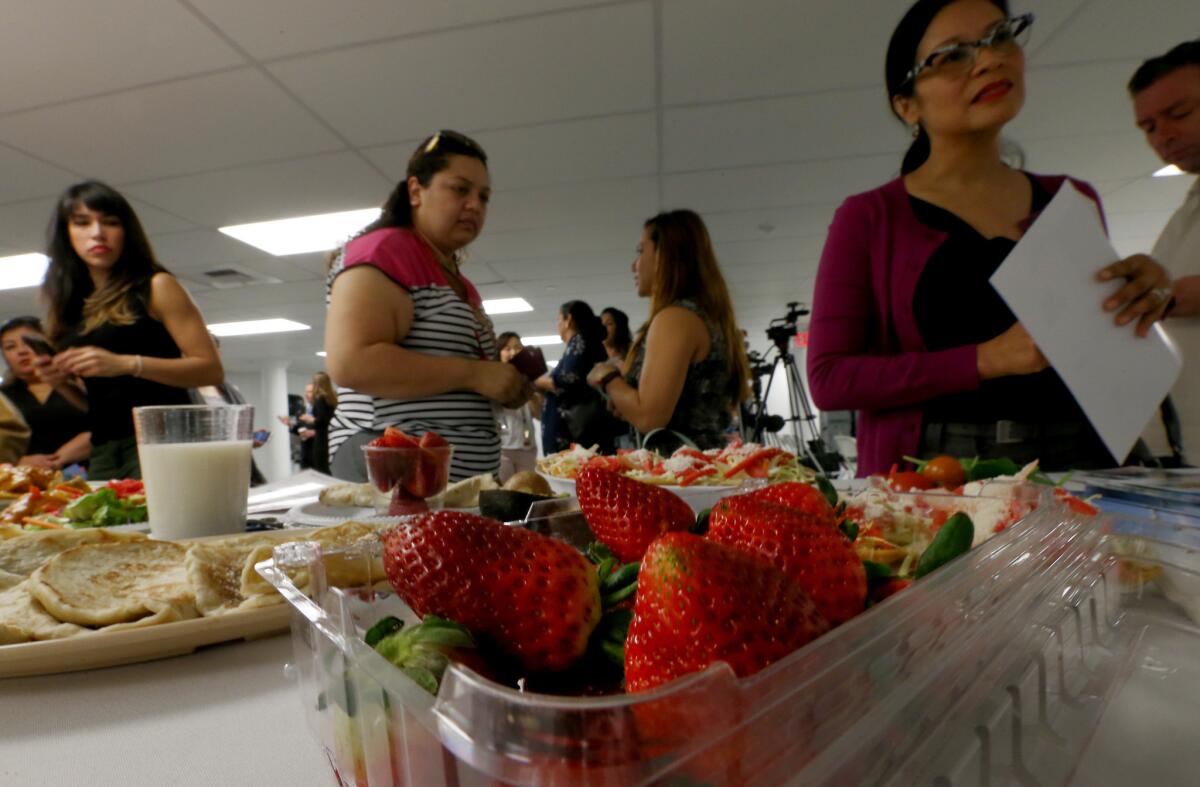L.A. County health officials want you to eat smaller portions at restaurants

Visitors to L.A. Kitchen look at healthy food options as the L.A. County Department of Public Health launches its “Healthy Eating Out” campaign.
- Share via
We’ve all heard it before: Too many Americans, more than one out of three, are obese, making them more likely to suffer from diabetes, stroke and heart disease.
But what can be done about a problem that’s so deeply ingrained in our culture? What people eat comes down to a complicated mix of preferences, location, access and behavior.
In New York, Former Mayor Michael Bloomberg tried to outlaw super-size sodas. Several years ago, the Los Angeles City Council banned new fast-food restaurants in parts of the city. The city of Berkeley passed a soda tax.
Now, in another attempt to reduce obesity rates, the Los Angeles County Public Health department is launching an advertising campaign to encourage parents and their kids to choose smaller portions and healthier foods the next time they eat out.
Though California has the fifth-lowest adult obesity rate in the nation, it has the highest obesity rate among low-income kids ages 2 to 4, with nearly 17% who are obese. Approximately 15% of all California kids are obese, according to national data.
L.A. County’s campaign message is simple: When eating out, eat less. And it doesn’t matter where you’re finding your next meal.
“Everyone points their fingers at fast food,” said Dr. Paul Simon, the department’s director of the Division of Chronic Disease and Injury Prevention, but “we’re missing the boat to some degree when we let other restaurants off the hook.”
Even meals at sit-down restaurants tend to be packed with calories, salt and fat, he said.
The ads, which began running Thursday and will continue through mid-March, will appear in Metro stations and trains, MTA buses, as well as radio stations and on social media, Simon said. They’ll be in English and Spanish, with some also in Korean, Mandarin and Cantonese, he said.
In one advertisement, a young girl holds a menu, next to “Tip #1 for eating out: Choose milk or water every time.” Another reads: “Tip #2 for eating out: Choose fruits or veggies on the side.”
Obesity is one of the biggest battles public health officials face. Rates have skyrocketed in America, from 15% in 1980 to 35% in 2010.
High obesity rates among children are particularly worrisome because they’re showing signs of diseases once seen only in adults — diabetes and liver damage — and they’re developing habits that could keep them unhealthy for the rest of their lives, Simon said.
“There’s clearly a need to intervene early ... to turn the curve on obesity and diabetes,” he said.
In October, the health department launched a different ad campaign called Water: The Healthiest Choice. In one poster, a young boy sips on a red straw, his face partly covered by the words “WARNING: Soda, sports & juice drinks can lead to childhood obesity and type 2 diabetes.”
Experts say there’s no easy solution to obesity, which is driven by eating and exercise habits that are closely linked to people’s lifestyles. That makes ending the epidemic as much of an uphill battle as tackling smoking was in the 1960s and 1970s, Simon said.
“The poster child for this is, of course, tobacco, where, over the course of 30 years, we really changed the norms around smoking,” he said. “It’s going to be very challenging, but we’re trying to change those norms around eating patterns as well.”
The new L.A. County ads don’t discriminate between types of restaurants. Research shows that kids consume about a third of their calories outside the home, and that it’s not just fast-food restaurants parents need to worry about.
One study found that at sit-down chain restaurants, meals contained 1,128 calories on average, more than half of the average daily 2,000-calorie recommendation for an adult.
Another study evaluated the calorie totals of meals at small chains and independent eateries, with similar results: too many calories.
“People are consuming far too many calories in a given meal,” Simon said.
He said he knows it can be difficult for restaurant owners to cut back on tasty yet unhealthful ingredients or scale down portion sizes and not lose customers.
But Kevin McCarney, founder of Mexican restaurant chain Poquito Mas, said he doesn’t view these adjustments as giving customers less, but just giving them more options.
In addition to the classic burritos, tacos and tostadas sold at Poquito Mas, customers also can buy smaller versions, called “Petitos.”
“The customer doesn’t have to choose between not having a burrito ... and having a burrito and having too much food,” McCarney said. “The idea is that sometimes people just want the craving of the food, that flavor, but we don’t want all the food.”
Poquito Mas is one of several establishments designated as “Choose Health L.A.” restaurants by the county health department. The dozens of restaurants that have qualified must offer smaller portion options as well as fruits and vegetables as sides for kids.
At a news conference Thursday unveiling the new ad campaign, Los Angeles County Supervisor Hilda Solis made a plea to Latino families, who tend to suffer from higher rates of obesity and diabetes.
Solis, who represents the San Gabriel Valley and much of East L.A., asked that parents think twice about what they’re feeding their kids. Her mother and father, she said, always made sure she had a glass of milk with her meals, and tried to not use too much oil when cooking. “Those are good things about our culture,” she said. “We know that we can do better.”
Follow @skarlamangla on Twitter for more health news.
ALSO
Resident of Yolo County tests positive for Zika virus
As more heat records broken, a toasty forecast predicted for L.A. Marathon
Get ready, L.A. -- Obama’s visit to bring heavy traffic
More to Read
Sign up for Essential California
The most important California stories and recommendations in your inbox every morning.
You may occasionally receive promotional content from the Los Angeles Times.











